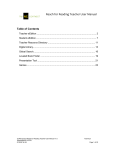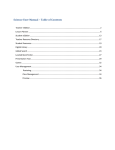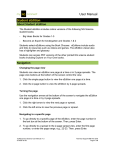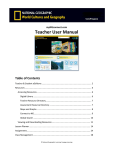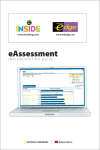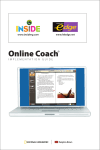Download User Manual PDF - REACH Student Help
Transcript
Reach Student User Manual Table of Contents Student eEdition……………………………………………………………… 2 Student Resources…………………………………………………………... 6 Digital Library…………………………………………………………………. 8 My Vocabulary Notebook……………………………………………………. 11 Games…………………………………………………………………………. 14 myNGconnect Reach Student User Manual v1.0 © NGSP & HB Technical Support 888-915-3276 Page 1 of 14 User Manual Student eEdition About Student eEdition The Student eEdition includes online versions of the NG Reach student books for levels B-F and online versions of Sing with Me Language Songs for levels A-F. Online Student eEditions are also available for Reach into Phonics Grades 1 and 2, which include Sing with Me Phonics Songs books and Read on Your Own books. Students and educators can select an eEdition to view and navigate through the online pages. They can also listen to Read with Me audio and watch Build Background Videos and Interactives. eEditions include a highlighter and glossary. (Read on Your Own books do not include audio or a glossary.) Navigation Changing the page view You can view your eEdition one page at a time or in 2-page spreads. Use the page view buttons at the bottom of the screen to change your view. 1. Click the single-page button to view the eEdition one page at a time. 2. Click the 2-page button to view the eEdition by 2-page spreads. Turning the page Use the navigation arrows at the bottom of the screen to navigate the eEdition one page at a time or by 2-page spreads. 1. Click the right arrow to view the next page or spread. 2. Click the left arrow to view the previous page or spread. Navigating to a specific page 1. To go directly to a specific page of the eEdition, enter the page number in the text box at the bottom of the screen. Then, press Enter on your keyboard. 2. To go directly to a spread in the 2-page spread view, enter the first page number of the spread, or enter the page range, e.g., 22-23. Then, press myNGconnect Reach Student User Manual v1.0 © NGSP & HB Technical Support 888-915-3276 Page 2 of 14 Enter on your keyboard. Zooming in and out You can expand or reduce your page view using the magnifying glass buttons at the bottom of the screen. Each time you click a magnifying glass, the view changes by 25%. 1. To zoom in, click the magnifying glass with the plus sign. You can expand your view up to 200%. 2. To zoom out, click the magnifying glass with the minus sign. You can reduce the view down to 75%. Changing books You can open a different online book with the Book Chooser, which is organized in two steps. In Step 1, the Book Chooser displays a carousel of Reach book covers for each level. In Step 2, the Book Chooser displays the available student eEditions based on your Step 1 selection. eEditions open in the myNGconnect eEdition viewer. To change books from an open eEdition: 1. Click the Book Chooser icon, which appears in the top tool bar. This will open the Book Chooser window. 2. For Step 1, click the back or forward arrow on the carousel to find another Reach book cover within that level. The available books will display under Step 2. 3. For Step 2, click the cover of the book you want to view. Highlights Highlighting content 1. To highlight content within the eEdition, click the highlighter tool in the top tool bar. Your cursor will become a plus sign (+). 2. Click and drag your cursor across the area of the page you wish to highlight. Release your cursor and the system will save your highlighting for future sessions. myNGconnect Reach Student User Manual v1.0 © NGSP & HB Technical Support 888-915-3276 Page 3 of 14 3. To remove highlighting, hover your cursor over the highlighted area. Click the close button that displays in the upper right of the highlighter block. Glossary Using the Glossary The eEdition Glossary includes all the terms from your Reach student books, arranged alphabetically. To use the Glossary: 1. Click the Glossary book icon located at the top right corner of the screen. The glossary will open in a pop-up window. 2. The Alphabet is listed across the top of the window. Click the first letter of the word you want to find. You will see a list of all the words starting with this letter on the left of the window. 3. Click the word in the word list. You will see its definition on the right of the screen. You will also see an audio icon, which you can click to hear the definition. 4. You can look for another word or click the close icon in the upper right of the Glossary window. Media Assets Playing audio Read with Me audio allows you to listen to all main Student Book selections. You can play Read with Me audio by clicking the round, blue speaker icon. Sing with Me audio plays chants, dialogues, poems, and songs. In the Student Book, a CD icon links to Sing with Me audio. The Sing with Me Language Songs and Sing with Me Phonics Songs books display a speaker icon for these links. To activate the audio: 1. Click the speaker icon or CD to start the audio for the main text. 2. Click the icon again to stop the main text audio. 3. Click the icon a third time to restart the audio. myNGconnect Reach Student User Manual v1.0 © NGSP & HB Technical Support 888-915-3276 Page 4 of 14 Playing a video You can play Build Background videos within the eEdition by clicking the NGReach.com link in the bottom right side of the unit opener. The video player will display in a pop-up window. 1. Click the play button to start viewing the video. 2. Click the pause button to stop the video at its current spot. Click play to restart the video. 3. Move the slider to jump to an earlier or later spot in the video. 4. Click the full-screen icon to expand the video to fill your screen. Click escape on your keyboard to close the full-screen view. 5. Click the close icon to close the video player. Viewing video captions The video player includes captions, which display below the video. 1. Click Captions On to see text captions below the video. 2. Click Captions Off to turn off the caption display. Adjusting video volume You can control volume using the controls in the video player. 1. Click the speaker icon to mute the volume. Click the speaker icon again to turn off mute. 2. To raise the volume, click and drag the volume bar to the right. 3. To lower the volume, click and drag the volume bar to the left. Playing an Interactive or Game Some Reach Build Background links in the student books open an Interactive instead of a video. Read on Your Own eEditions provide links to game sets. You can launch Interactives by clicking the NGReach.com link at the bottom right side of the unit opener. The Interactive will launch in the myNGconnect Flash player. Click the Go! link in the Read on Your Own eEdition to launch a game set. Game sets open in the Game Menu for each skill. myNGconnect Reach Student User Manual v1.0 © NGSP & HB Technical Support 888-915-3276 Page 5 of 14 User Manual Student Resources About Student Resources Student Resources give students online access to videos, interactives, images, MP3s, web links, and PDFs, which accompany NG Reach instruction. Resources include Build Background videos, Sing with Me audio, Read with Me audio, Digital Library images, and worksheets. Navigation To access Student Resources, click the Resources button on the student homepage. A book chooser pop-up displays for students who are subscribed to a main Reach level and Reach into Phonics. Once arriving at the resource menu, follow these steps to navigate through the available resources: 4. Click a unit. 5. Click a resource type. For example, Build Background Video, Sing with Me, Read with Me, Practice Books, or Language Builder Picture Cards. 6. Click the resource you would like to open. Resources open in the corresponding viewer. Teamwork Activities, Audio, and Images Teamwork Activities Cross-curricular and Language and Literacy Teamwork Activity resources include web links, articles, and images. Accessing these resources involves four steps. 1. Click a unit. 2. Click Cross-curricular or Language and Literacy Teamwork Activities 3. Choose a card and resource type. 4. Click the resource. (In most cases, you'll see only one choice for Step 4.) myNGconnect Reach Student User Manual v1.0 © NGSP & HB Technical Support 888-915-3276 Page 6 of 14 Downloading an audio MP3 You can download Read with Me and Sing with Me audio files to your desktop. 1. Navigate through the 3-step menu to find the audio file you would like to down load. 2. In Step 3, click the save link. This will open a new window where you can select “Save As…” Images Student Resource images open through the Digital Library. After selecting an image resource type such as Language Builder Picture Cards, students will a mini version of the Digital Library search results screen with the corresponding collection of images. myNGconnect Reach Student User Manual v1.0 © NGSP & HB Technical Support 888-915-3276 Page 7 of 14 User Manual Digital Library About Digital Library The Digital Library enables users to easily search & browse images and videos, and provides teachers with a means to add media resources to their Lesson Planner activities. Search Performing a Simple Search The initial view of Digital Library contains a Simple Search function for locating videos or images. 7. To search, enter your term(s) in the Search field and click the Search button. 8. This will display your Search Results. 9. From this screen, you may view details of the resulting videos/images, or refine your search using the Filter drop-downs on the left. 10. Click the small thumbnail image to see the details for the resource. Browse Browsing by categories The initial view of Digital Library contains a Browse Categories function for locating videos or images. 1. To browse the Digital Library categories, click either the Reach or Science tab. 2. Choose from the left menu. 3. On the right side select an appropriate category. 4. The videos/images will display from the categories you selected. From this screen, you may view details of the resulting videos/images, or refine your search using the drop-downs on the left. 5. Click the small thumbnail image to see the details for the resource. myNGconnect Reach Student User Manual v1.0 © NGSP & HB Technical Support 888-915-3276 Page 8 of 14 Resource Details Page Previewing Details 1. To preview the Details of Digital Library videos/images, first locate the videos/images using the Search or Browse Category function. 2. Hover over the item with your mouse; this will display the Details, such as unit and description, for the item. Viewing a resource 1. To view a resource from Digital Library, click the thumbnail image from the search results screen. This will display all the item’s Details, as well as the video/image itself. Previewing an image 1. To preview an image, after locating the image through Search or Browse Category, click the small thumbnail image to view the item. 2. This will display the Details of the image, along with the image/video displayed in the top right corner of the screen. Click the Preview button, located above the image, to launch the image in a larger viewer. Downloading an image 1. To download an image, after locating the image through Search or Browse Category, click the thumbnail image to view the item. 2. This will display the Details of the image, along with the image displayed in the top right corner of the screen. Click the Download button, located above the image, to download the file. 3. This will open the image in a new window, right-click the image and choose “Save image as…” from the menu. Filter Filtering results Filters, such as Level/Grade and Unit, can help refine your search and uncover the video or image you are looking for. myNGconnect Reach Student User Manual v1.0 © NGSP & HB Technical Support 888-915-3276 Page 9 of 14 1. To search using filters, first enter your search term(s) in the initial Search field on the main Digital Library screen. Then click the Search button. This will display your Search Results. NOTE: You may also search using the Browse Categories function. 2. From this screen, you may use the Filter drop-downs to refine your search. Click the appropriate drop-down to select the Level/Grade, Unit, and/or Resource Type for the video/image, then click Search to view the filtered results. myNGconnect Reach Student User Manual v1.0 © NGSP & HB Technical Support 888-915-3276 Page 10 of 14 User Manual My Vocabulary Notebook About My Vocabulary Notebook My Vocabulary Notebook allows students to create a personal dictionary. Users can enter words they know or would like to learn more about, rate how well they know the word, and gather more information about the word to increase their understanding over time. Accessing My Vocabulary Notebook My Vocabulary Notebook can be launched in three ways: 11. From the My Vocabulary Notebook button on the Student homepage. 12. From the My Vocabulary Notebook icon in the toolbar at the top of the Student eEdition. 13. From the “Add to My Vocabulary Notebook” link in the glossary. When the application is launched, it will open in a pop-up window over the screen. Close the pop-up to return to the previous screen. Navigation The initial view of My Vocabulary Notebook will show a blank word list on the left side. As you add words, they will appear in the list. From the word list, you can click a word to view its details, or click the letters to show all words that begin with that letter. At the top of the word list you can click “Add Word” to add a word to your notebook, or filter the words that appear in the word list. On the right side, you will see the form to add a new word. Adding a word Word entry form 3. To add a word, open the application to bring up the word entry form. You can also click the “Add word” button from anywhere else in the application. 4. Type the word in the field, and then add the part of speech from the dropdown menu. Finally, rate how well you know the word. 5. After you complete the three fields, the Save buttons will become active. You cannot add a word without completing all fields. Click “Save” to save myNGconnect Reach Student User Manual v1.0 © NGSP & HB Technical Support 888-915-3276 Page 11 of 14 your word to your notebook and close the application. Click “Save and Add Another” to save the word and continue adding more words. 6. If you decide you do not want to save the word, click “Cancel”. 7. You can also add a word from the glossary by opening the glossary application, navigating to the word, and clicking the “Add to My Vocabulary Notebook” link. My Vocabulary Notebook will launch with the word and part of speech already entered. Simply rate how well you know the word and click Save to add it to your notebook. 8. If you enter a word that is already in your notebook, you will see a notice that reads, “This word is already in your notebook”. From there you can click the link to the word’s definitions page. Definitions page After a word is added, go to the definitions page to add the definition(s). 1. When you first add a word, the part of speech will be visible with text instructing you to add the first definition. Click the link to bring up the definition entry screen. 2. Enter the definition in the text box and click “Save”. 3. You can enter additional definitions, change parts of speech, and edit existing definition. 4. If the word you enter is a Key Word from the Student Edition, it will have the definition from the Student Edition entered. You will not be able to edit this definition or part of speech. However, you can add other definitions. 5. After the definition has been added, it will appear on the definitions page along with links to “Edit the definition” and “Add more information”. Click the “Add more information” link to access the word details and enter more information about the word. Word details For each definition, click the “Add more information” link to access the word details page. Here, you can add more information about the word as you gain more understanding. 1. At the top you will see the word, the part of speech, the definition, and the last date that you viewed and edited that definition. If the word is a Key Word, you will see a blue audio icon and a picture. Click the audio icon to listen to the word and definition. Click the icon again to stop the audio. Click the picture to enlarge it and see the word used in a sentence. Click the picture again to close it. myNGconnect Reach Student User Manual v1.0 © NGSP & HB Technical Support 888-915-3276 Page 12 of 14 2. At the bottom of the page you will see three tabs, “Add What I Know”, “Use This Word”, and “Rate this Word”. These tabs contain fields for you to add more information about that definition. As you complete these fields, you will be prompted to save. When the save button is clicked, the activity will show a check mark next to the title. You can go back and edit these fields at any time. 3. The “Rate This Word” tab shows your ratings history. You can continue to rate the word as you gain understanding of it and the date will be added to the list. 4. Click the “Back” button to return to the definitions page, or use the word list to jump to a new word. myNGconnect Reach Student User Manual v1.0 © NGSP & HB Technical Support 888-915-3276 Page 13 of 14 User Manual About Games Games are available online that provide a learning experience focusing on specific Phonics and Word Building skills. Accessing Games Games can be launched 2 different ways: 1. From the Phonics Student eEdition 2. From the Student homepage Navigation From the Student homepage 1. 2. 3. 4. 5. Choose games from the Student homepage Choose a program set Choose a unit Choose a game set A menu will launch in a separate window, choose a game and play From the Student eEdition 1. Click the Phonics Games link located in the Read On Your Own student eEdition. 2. A game set menu will launch in a separate window, choose a game and play myNGconnect Reach Student User Manual v1.0 © NGSP & HB Technical Support 888-915-3276 Page 14 of 14














